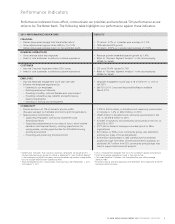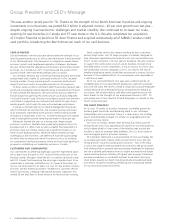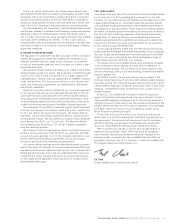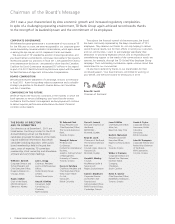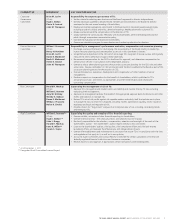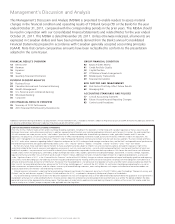TD Bank 2011 Annual Report Download - page 14
Download and view the complete annual report
Please find page 14 of the 2011 TD Bank annual report below. You can navigate through the pages in the report by either clicking on the pages listed below, or by using the keyword search tool below to find specific information within the annual report.TD BANK GROUP ANNUAL REPORT 2011 MANAGEMENT’S DISCUSSION AND ANALYSIS12
SIGNIFICANT EVENTS IN 2011
Acquisition of MBNA Canada’s credit card business
On or about December 1, 2011, the Bank is expected to complete
the acquisition of substantially all of the credit card portfolio of MBNA
Canada, a wholly-owned subsidiary of Bank of America Corporation,
as well as certain other assets and liabilities. At closing, the Bank will
pay a premium of approximately $75 million on the portfolio, which
is expected to total approximately $7.8 billion at December 1, 2011.
The acquisition will be accounted for by the purchase method.
On a pro forma basis, the Bank’s Tier 1 Capital ratio would have
been 44 basis points lower as at October 31, 2011 had the acquisition
closed before year-end.1 The pro forma impact does not include the
common shares issued in September 2011. The net impact of the
acquisition on the Bank’s Tier 1 Capital ratio including the common
shares issued would have been negative 12 basis points as at
October 31, 2011.
Acquisition of Chrysler Financial
On April 1, 2011, the Bank acquired 100% of the outstanding equity
of Chrysler Financial in Canada and the U.S. for cash consideration of
approximately $6,390 million including contingent consideration. As
part of the purchase agreement, the Bank is required to pay additional
cash consideration in the event that amounts realized on certain assets
exceed a pre-established threshold. Under Canadian GAAP, contingent
consideration is recorded as part of the purchase price, when the
amount can be reasonably estimated and the outcome is determinable
beyond a reasonable doubt. During September 2011, the amounts
realized on these assets exceeded the threshold and the Bank was
required to pay cash consideration of $70 million. The acquisition
was accounted for by the purchase method. The results of Chrysler
Financial from the acquisition date to October 31, 2011 have been
consolidated with the Bank’s results. The results of Chrysler Financial
in the U.S. are reported in the U.S. Personal and Commercial Banking
segment. The results of Chrysler Financial in Canada are reported in
the Canadian Personal and Commercial Banking segment. As at April
1, 2011, the acquisition contributed $3,081 million of net cash and
cash equivalents, $7,322 million of loans, $2,235 million of other
assets, and $6,490 million of liabilities. The estimated fair value for
loans reflects the expected credit losses at the acquisition date. The
excess of the fair value of the identifiable assets acquired over that
of the liabilities assumed of approximately $242 million has been
allocated to goodwill, which increased by $73 million, during the
period from acquisition date to October 31, 2011, primarily due to the
recognition of contingent consideration. The purchase price allocation
is subject to refinement as the Bank completes the valuation of the
assets acquired and liabilities assumed. As at October 31, 2011,
Chrysler Financial contributed $69 million of net cash and cash
equivalents, $7,885 million of loans, $1,615 million of other assets,
and $3,058 million of liabilities. Included in loans is $518 million of
acquired credit-impaired loans.
Acquisition of TMX Group
On October 30, 2011, TMX Group Inc. (TMX) and Maple Group
Acquisition Corporation (Maple) announced that they have entered
into a support agreement in respect of Maple’s proposed acquisition of
all of the outstanding TMX shares pursuant to an integrated two-step
transaction valued at approximately $3,800 million. The first step of
the integrated acquisition transaction will involve acquisition of 70%
to 80% of the TMX Group shares for $50 in cash per share, on a pro
rated basis, to be followed by a second step court approved plan of
arrangement that will provide shareholders (other than Maple) with
Maple shares in exchange for their remaining TMX Group shares.
Maple is a corporation whose investors comprise 13 of Canada’s lead-
ing financial institutions and pension funds, including TD Securities
Inc., a wholly owned subsidiary of the Bank. As part of the proposed
transaction, TD Securities has made an equity commitment of up
to $192 million. TMX and Maple are working diligently to obtain all
approvals required for the completion of Maple’s offer, including
approvals by securities regulators and the Competition Bureau. In
connection with entering into the support agreement, Maple has
agreed to extend its offer associated with the first step of the above
noted transaction until January 31, 2012.
U.S. Legislative Developments
On July 21, 2010 the President of the United States signed into law
the Dodd-Frank Wall Street Reform and Consumer Protection Act
(the “Dodd-Frank Act” or “the Act”) that provides for widespread
changes to the U.S. financial industry. At over 2,300 pages in length,
the Dodd-Frank Act will ultimately affect virtually every financial insti-
tution operating in the United States, including the Bank, and, due to
certain extraterritorial aspects of the Act, may impact the Bank’s oper-
ations outside the United States. The Dodd-Frank Act makes significant
changes in areas such as banking and bank supervision, the resolution
of, and enhanced prudential standards applicable to, systemically
important financial companies, proprietary trading and certain fund
investments, consumer protection, securities, over-the-counter deriva-
tives, and executive compensation, among others. The Dodd-Frank Act
also calls for the issuance of over 240 pieces of regulatory rulemaking
as well as numerous studies and on-going reports as part of its imple-
mentation. Accordingly, while the Act will have an effect on the busi-
ness of the Bank, especially its business operations in the United
States, the full impact on the Bank will not be known until such time
as the implementing regulations are fully released and finalized.
On November 10, 2011, the Department of the Treasury, the Board
of Governors of the Federal Reserve System, the Federal Deposit
Insurance Corporation and the Securities and Exchange Commission
jointly released a proposed rule implementing Section 619 of the
Dodd-Frank Act (the “Volcker Rule”). The Bank is in the process of
analyzing and planning for the implementation of the proposed
Volcker Rule. The Volcker Rule broadly prohibits proprietary trading
and places limitations on so-called permitted trading activities, limits
investments in and the sponsorship of hedge and private equity funds
and requires robust compliance and reporting regimes surrounding
permitted activities. Under the current proposal, the provisions of the
Volcker Rule are applicable to banking entities, including non-U.S.
banks such as the Bank which control insured depository institutions
in the United States or are treated as bank holding companies by virtue
of maintaining a state branch or agency. The proposed Volcker rule
applies to affiliates or subsidiaries of the Bank: the terms “affiliate”
and “subsidiary” are defined by the rule to include those entities
controlled by or under common control with the Bank. The Volcker
Rule will also have an effect on certain of the funds the Bank sponsors
and advises in its asset management business as well as private equity
investments it currently has made.
Although the regulatory guidance is not yet finalized, as part of its
implementation plan, the Bank will be required to distinguish between
prohibited proprietary trading businesses and businesses that primarily
engage in ‘permitted activities’ under the Volcker Rule. The Bank
regards proprietary trading businesses as those where the primary
activity is to build an inventory position in securities, derivatives or
other instruments using the Bank’s own funds or capital, as opposed
to client funds, with the overall objective of profiting from short-term
movements in prices for the Bank’s own account. In addition, proprietary
trading businesses do not have formal market-making responsibilities,
or other risk management accountabilities and deal primarily or exclu-
sively with inter-bank counterparties. They are also typically organiza-
tionally or operationally separate from market-making activities.
While the Volcker Rule will have an effect on the business of the
Bank, the extent of the impact on the Bank will not be known until
such time as the current proposal is finalized.
1 Estimates are subject to risks and uncertainties that may cause actual results to
differ materially; and TD’s expectations are based on certain factors and assump-
tions. See the “Caution regarding forward-looking statements” included in the
Bank’s press release dated August 15, 2011, which is available on the Bank’s
website at www.td.com, as well as on SEDAR at www.sedar.com and on the
SEC’s website at www.sec.gov (EDGAR filers section).



